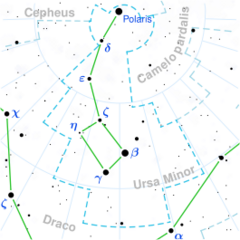Astronomy:HD 117566
| Observation data Epoch J2000.0 Equinox (celestial coordinates) | |
|---|---|
| Constellation | Camelopardalis |
| Right ascension | 13h 26m 56.80348s[1] |
| Declination | +78° 38′ 37.9324″[1] |
| Apparent magnitude (V) | 5.74±0.01[2] |
| Characteristics | |
| Evolutionary stage | Hertzsprung gap[3] or horizontal branch[4] |
| Spectral type | G3 IIIb Fe−1 CH1[5] |
| U−B color index | +0.35[6] |
| B−V color index | +0.77[6] |
| Astrometry | |
| Radial velocity (Rv) | 13.7±0.3[7] km/s |
| Proper motion (μ) | RA: −140.497[1] mas/yr Dec.: +30.403[1] mas/yr |
| Parallax (π) | 11.1974 ± 0.0417[1] mas |
| Distance | 291 ± 1 ly (89.3 ± 0.3 pc) |
| Absolute magnitude (MV) | +1.03[8] |
| Details | |
| Mass | 2.29[9] M☉ |
| Radius | 7.2±0.4[10] R☉ |
| Luminosity | 38.2±0.3[1] L☉ |
| Surface gravity (log g) | 3.69±0.18[11] cgs |
| Temperature | 5,420±26[12] K |
| Metallicity [Fe/H] | +0.03[11] dex |
| Rotational velocity (v sin i) | 8.9±1[13] km/s |
| Age | 760±50[7] Myr |
| Other designations | |
| Database references | |
| SIMBAD | data |
HD 117566, also known as HR 5091, is a solitary yellow-hued star[15] located in the northern circumpolar constellation Camelopardalis. It has an apparent magnitude of 5.74,[2] making it faintly visible to the naked eye. This object is relatively close at a distance of 291 light years based on Gaia DR3 parallax measurements but is receding with a heliocentric radial velocity of 14 km/s.[7] At its current distance, HD 117566's brightness is diminished by 0.12 magnitudes due to interstellar dust.[16]
HD 117566 has a stellar classification of G3 IIIb Fe−1 CH1,[5] indicating that it is a G-type giant with an under-abundance of iron and an overabundance of the CH radical in its spectrum. Its evolutionary stage is unclear. A 1994 paper places it in the Hertzsprung gap,[3] indicating it has ceased hydrogen core fusion and is now evolving toward the red giant branch (RGB). However, Mishenina et al. (2006) said that HD 117566 is already past the RGB and is on the horizontal branch, fusing helium at its core.[4] Nevertheless, it has 2.29 times the mass of the Sun[9] and, at the age of 760 million years,[7] it has expanded to 7.2 times the Sun's radius.[10] It radiates 38.2 times the luminosity of the Sun[1] from its photosphere at an effective temperature of 5,420 K.[12] HD 117566 has a solar metallicity[11] and spins modestly with a projected rotational velocity of 9 km/s.[13]
References
- ↑ 1.0 1.1 1.2 1.3 1.4 1.5 Vallenari, A. et al. (2022). "Gaia Data Release 3. Summary of the content and survey properties". Astronomy & Astrophysics. doi:10.1051/0004-6361/202243940 Gaia DR3 record for this source at VizieR.
- ↑ 2.0 2.1 Høg, E.; Fabricius, C.; Makarov, V. V.; Urban, S.; Corbin, T.; Wycoff, G.; Bastian, U.; Schwekendiek, P. et al. (March 2000). "The Tycho-2 catalogue of the 2.5 million brightest stars". Astronomy and Astrophysics 355: L27–L30. ISSN 0004-6361. Bibcode: 2000A&A...355L..27H.
- ↑ 3.0 3.1 Wallerstein, George; Bohm-Vitense, Erika; Vanture, Andrew D.; Gonzalez, Guillermo (June 1994). "The lithium content and other properties of F2-G5 giants in the Hertzsprung Gap". The Astronomical Journal 107: 2211. doi:10.1086/117031. ISSN 0004-6256. Bibcode: 1994AJ....107.2211W.
- ↑ 4.0 4.1 Mishenina, T. V.; Bienaymé, O.; Gorbaneva, T. I.; Charbonnel, C.; Soubiran, C.; Korotin, S. A.; Kovtyukh, V. V. (September 2006). "Elemental abundances in the atmosphere of clump giants". Astronomy & Astrophysics 456 (3): 1109–1120. doi:10.1051/0004-6361:20065141. ISSN 0004-6361. Bibcode: 2006A&A...456.1109M.
- ↑ 5.0 5.1 Keenan, Philip C.; McNeil, Raymond C. (October 1989). "The Perkins catalog of revised MK types for the cooler stars". The Astrophysical Journal Supplement Series 71: 245. doi:10.1086/191373. ISSN 0067-0049. Bibcode: 1989ApJS...71..245K.
- ↑ 6.0 6.1 Mermilliod, J.-C. (1986), "Compilation of Eggen's UBV data, transformed to UBV (unpublished)", Catalogue of Eggen's UBV Data. SIMBAD, Bibcode: 1986EgUBV........0M
- ↑ 7.0 7.1 7.2 7.3 Soubiran, C.; Bienaymé, O.; Mishenina, T. V.; Kovtyukh, V. V. (9 January 2008). "Vertical distribution of Galactic disk stars". Astronomy & Astrophysics 480 (1): 91–101. doi:10.1051/0004-6361:20078788. ISSN 0004-6361. Bibcode: 2008A&A...480...91S.
- ↑ Anderson, E.; Francis, Ch. (May 2012). "XHIP: An extended hipparcos compilation". Astronomy Letters 38 (5): 331–346. doi:10.1134/S1063773712050015. ISSN 1063-7737. Bibcode: 2012AstL...38..331A.
- ↑ 9.0 9.1 Liu, Y. J.; Tan, K. F.; Wang, L.; Zhao, G.; Sato, Bun'ei; Takeda, Y.; Li, H. N. (31 March 2014). "The Lithium Abundances of a Large Sample of Red Giants". The Astrophysical Journal 785 (2): 94. doi:10.1088/0004-637X/785/2/94. ISSN 0004-637X. Bibcode: 2014ApJ...785...94L.
- ↑ 10.0 10.1 Kervella, P.; Thévenin, F.; Di Folco, E.; Ségransan, D. (October 2004). "The angular sizes of dwarf stars and subgiants". Astronomy & Astrophysics 426 (1): 297–307. doi:10.1051/0004-6361:20035930. ISSN 0004-6361. Bibcode: 2004A&A...426..297K.
- ↑ 11.0 11.1 11.2 da Silva, Ronaldo; Milone, André de C.; Rocha-Pinto, Helio J. (August 2015). "Homogeneous abundance analysis of FGK dwarf, subgiant, and giant stars with and without giant planets". Astronomy and Astrophysics 580: A24. doi:10.1051/0004-6361/201525770. ISSN 0004-6361. Bibcode: 2015A&A...580A..24D.
- ↑ 12.0 12.1 Strassmeier, K.G.; Schordan, P. (December 2000). "A temperature calibration for MK-class III giants from high-resolution spectral line-depth ratios". Astronomische Nachrichten 321 (5–6): 277–305. doi:10.1002/1521-3994(200012)321:5/6<277::AID-ASNA277>3.0.CO;2-H. ISSN 0004-6337. Bibcode: 2000AN....321..277S.
- ↑ 13.0 13.1 De Medeiros, J. R.; Alves, S.; Udry, S.; Andersen, J.; Nordström, B.; Mayor, M. (January 2014). "A catalog of rotational and radial velocities for evolved stars". Astronomy & Astrophysics 561: A126. doi:10.1051/0004-6361/201220762. ISSN 0004-6361. Bibcode: 2014A&A...561A.126D.
- ↑ "HD 117566". SIMBAD. Centre de données astronomiques de Strasbourg. http://simbad.u-strasbg.fr/simbad/sim-basic?Ident=HD+117566.
- ↑ Eggleton, P. P.; Tokovinin, A. A. (11 September 2008). "A catalogue of multiplicity among bright stellar systems". Monthly Notices of the Royal Astronomical Society 389 (2): 869–879. doi:10.1111/j.1365-2966.2008.13596.x. ISSN 0035-8711. Bibcode: 2008MNRAS.389..869E.
- ↑ Gontcharov, George A.; Mosenkov, Aleksandr V. (28 September 2017). "Verifying reddening and extinction for Gaia DR1 TGAS main sequence stars". Monthly Notices of the Royal Astronomical Society 472 (4): 3805–3820. doi:10.1093/mnras/stx2219. ISSN 0035-8711. Bibcode: 2017MNRAS.472.3805G.
 |


